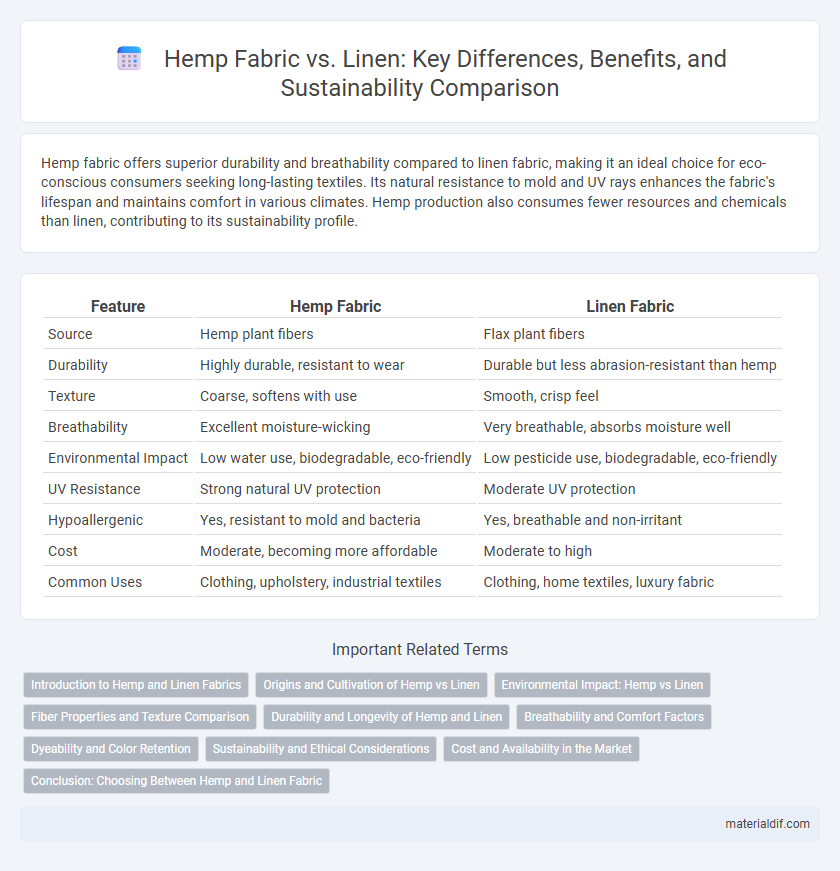Hemp fabric offers superior durability and breathability compared to linen fabric, making it an ideal choice for eco-conscious consumers seeking long-lasting textiles. Its natural resistance to mold and UV rays enhances the fabric's lifespan and maintains comfort in various climates. Hemp production also consumes fewer resources and chemicals than linen, contributing to its sustainability profile.
Table of Comparison
| Feature | Hemp Fabric | Linen Fabric |
|---|---|---|
| Source | Hemp plant fibers | Flax plant fibers |
| Durability | Highly durable, resistant to wear | Durable but less abrasion-resistant than hemp |
| Texture | Coarse, softens with use | Smooth, crisp feel |
| Breathability | Excellent moisture-wicking | Very breathable, absorbs moisture well |
| Environmental Impact | Low water use, biodegradable, eco-friendly | Low pesticide use, biodegradable, eco-friendly |
| UV Resistance | Strong natural UV protection | Moderate UV protection |
| Hypoallergenic | Yes, resistant to mold and bacteria | Yes, breathable and non-irritant |
| Cost | Moderate, becoming more affordable | Moderate to high |
| Common Uses | Clothing, upholstery, industrial textiles | Clothing, home textiles, luxury fabric |
Introduction to Hemp and Linen Fabrics
Hemp fabric, derived from the fibers of the Cannabis sativa plant, boasts exceptional durability, breathability, and natural resistance to UV rays and mold, making it an eco-friendly textile choice. Linen fabric, produced from the flax plant, is renowned for its lightweight texture, moisture-wicking properties, and crisp feel, offering comfort and elegance in warm climates. Both fabrics are sustainable alternatives to conventional textiles, with hemp providing a stronger, more antibacterial option and linen excelling in softness and drape.
Origins and Cultivation of Hemp vs Linen
Hemp fabric originates from the stalks of the Cannabis sativa plant, cultivated for thousands of years primarily in Asia and Europe due to its hardy growth and low water requirements. Linen fabric is derived from the flax plant (Linum usitatissimum), traditionally grown in cooler climates like Northern Europe with a cultivation process demanding more precise soil and weather conditions. Both plants offer sustainable textile sources, but hemp's rapid growth cycle and resistant nature provide an ecological advantage over flax in fiber production.
Environmental Impact: Hemp vs Linen
Hemp fabric demonstrates a significantly lower environmental impact compared to linen due to its rapid growth cycle and minimal pesticide requirements, enabling it to sequester more carbon and regenerate soil health effectively. Linen, derived from flax fibers, consumes considerable water and often involves intensive retting processes that can contribute to water pollution. Both fabrics are biodegradable, but hemp's resilience allows for higher yields per acre, making it a more sustainable textile choice in terms of resource efficiency and ecological footprint.
Fiber Properties and Texture Comparison
Hemp fabric boasts superior durability and resistance to wear due to its strong, coarse fibers, making it ideal for heavy-duty applications, while linen fabric, derived from flax fibers, offers a softer, smoother texture with a moderate strength level. The breathability of hemp fabric surpasses that of linen, as its fibers allow better moisture wicking and faster drying, enhancing comfort in warm climates. Hemp's natural anti-bacterial properties contrast with linen's hypoallergenic qualities, influencing their respective uses in textiles focused on sustainability and skin sensitivity.
Durability and Longevity of Hemp and Linen
Hemp fabric offers superior durability compared to linen, with its fibers being longer and stronger, resulting in increased resistance to wear and tear. Hemp's natural resistance to mold, UV rays, and mildew enhances its longevity, making it ideal for long-lasting textiles. While linen is durable, hemp's robustness and ability to soften over time without losing strength make it the preferred choice for sustainable, long-wearing fabrics.
Breathability and Comfort Factors
Hemp fabric offers superior breathability compared to linen, as its natural fibers allow for excellent air circulation and moisture-wicking properties. The durability and softness of hemp improve with each wash, enhancing comfort without sacrificing strength or texture. Linen provides a lightweight feel but tends to wrinkle easily, making hemp a more reliable choice for long-lasting comfort and breathability in everyday wear.
Dyeability and Color Retention
Hemp fabric demonstrates superior dyeability compared to linen due to its coarser fiber structure, allowing deeper pigment absorption and richer color vibrancy. Hemp retains color longer under repeated washing and UV exposure, supported by its natural resistance to fading and environmental degradation. In contrast, linen fabric's smoother fibers result in lighter dye uptake and quicker color fading over time, making hemp a preferred choice for durable, colorfast textile products.
Sustainability and Ethical Considerations
Hemp fabric outperforms linen fabric in sustainability due to its lower water consumption and faster growth cycle, requiring minimal pesticides and synthetic fertilizers. Ethically, hemp cultivation promotes soil health and supports regenerative agriculture, while linen production often involves intensive processing that can harm ecosystems. Choosing hemp fabric aligns with eco-friendly and socially responsible fashion practices, reducing environmental impact and fostering fair labor conditions.
Cost and Availability in the Market
Hemp fabric generally costs less than linen due to its faster growth cycle and higher yield per acre, making it more economically feasible for large-scale production. The availability of hemp fabric has increased significantly as hemp cultivation expands globally, driven by changing regulations and growing demand for sustainable textiles. Linen fabric remains less available and more expensive, as flax crops require longer growing periods and specialized processing.
Conclusion: Choosing Between Hemp and Linen Fabric
Hemp fabric offers superior durability, moisture-wicking properties, and environmental sustainability compared to linen fabric, making it ideal for eco-conscious consumers seeking long-lasting textiles. Linen fabric provides a softer texture and a more traditional aesthetic, appealing to those prioritizing comfort and classic style. The choice between hemp and linen fabric hinges on balancing sustainability, durability, and tactile preference in textile selection.
Hemp Fabric vs Linen Fabric Infographic

 materialdif.com
materialdif.com